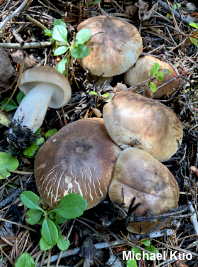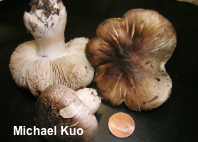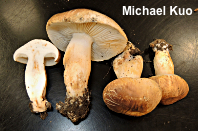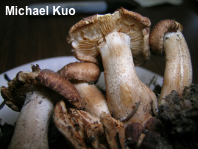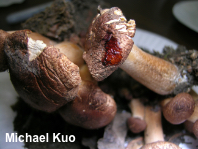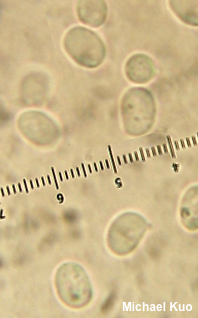| Major Groups > Gilled Mushrooms > Pale-Spored > Tricholoma > Tricholoma imbricatum |

|
Tricholoma imbricatum [ Basidiomycota > Agaricales > Tricholomataceae > Tricholoma . . . ] by Michael Kuo Found under pines (species of Pinus, with bundled needles), Tricholoma imbricatum features a medium to dark brown cap that becomes finely scaly as it develops. It features a solid stem that does not usually become hollow with age, and thick white flesh that sometimes turns slightly pinkish when sliced. The odor ranges from not distinctive to sweet or mealy. Tricholoma vaccinum is similar, but grows under spruces and features a reddish brown to orangish brown cap that becomes much more scaly, as well as a hollowing stem. Microscopic features for these species are too close to be used for identification decisions. The "true" Tricholoma imbricatum is a European species originally described from Scandinavia (Fries, 1815) when Abraham Lincoln was six years old. Although the name is regularly applied to North American mushrooms, it is doubtful that our versions of the species actually correspond, phylogenetically, to the European species. One recent DNA survey (Heilmann-Clausen et al. 2017) found that "[t]he included North American sequence of T. imbricatum is quite deviant from the two European sequences, and might represent a distinct species." Description: Ecology: Mycorrhizal with pines (species of Pinus); growing alone, scattered, or gregariously; summer and fall (also over winter in warm climates); widely reported in North America but much more common from the Rocky Mountains westward. The illustrated and described collections are from Colorado. Cap: 3–10 cm; convex, becoming broadly convex or broadly bell-shaped; dry; radially appressed-fibrillose and streaked in appearance; usually becoming finely scaly; often developing radial splits and fissures; medium to dark brown, with a paler marginal area. Gills: Attached to the stem by a notch; close; short-gills frequent; whitish to yery pale yellowish; discoloring and spotting brownish with age. Stem: 3–8 cm long; 1–2.5 cm thick; club-shaped above a pinched base; whitish at the top, but brownish to brown below; usually not becoming hollow; basal mycelium white. Flesh: Whitish; not changing on exposure, or changing to pale pinkish in places. Odor and Taste: Odor sweetish, slightly mealy, or not distinctive; taste not distinctive, or slightly bitter and farinaceous. Chemical Reactions: KOH negative or red on cap surface. Spore Print: White. Microscopic Features: Spores 4–8 x 4–6 µm; broadly ellipsoid or occasionally subglobose; smooth; hyaline in KOH; inamyloid. Basidia 4-sterigmate. Pleurocystidia and cheilocystidia not found. Lamellar trama parallel. Pileipellis a cutis of cylindric elements 5–7.5 µm wide; brown in KOH. Clamp connections not found. REFERENCES: (Fries, 1815) Kummer, 1871. (Fries, 1828; Quélet, 1886; Kauffman, 1918; Ovrebo, 1973; Smith, 1975; Smith, Smith & Weber, 1979; Ovrebo, 1980; Arora, 1986; Breitenbach & Kränzlin, 1991; Lincoff, 1992; Shanks, 1994; McNeil, 2006; Trudell & Ammirati, 2009; Bessette et al., 2013; Christensen & Heilmann-Clausen, 2013; Desjardin, Wood & Stevens, 2015; Siegel & Schwarz, 2016; Heilmann-Clausen et al., 2017.) Herb. Kuo 08291104, 08171405, 08101807. Herb. DBG RMNP 2008-170. This site contains no information about the edibility or toxicity of mushrooms. |
© MushroomExpert.Com |
|
Cite this page as: Kuo, M. (2019, August). Tricholoma imbricatum. Retrieved from the MushroomExpert.Com Web site: http://www.mushroomexpert.com/tricholoma_imbricatum.html |
